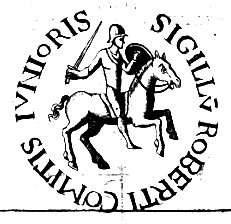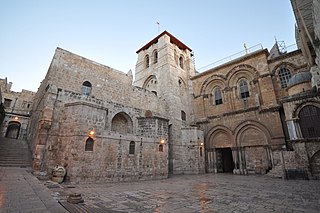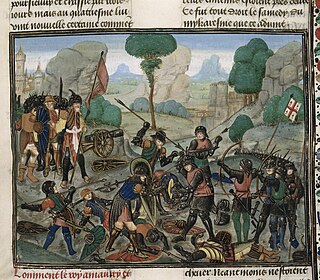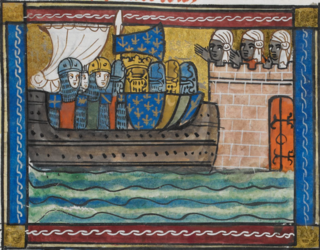Works
Andrew's chief work was Miracula sancti Benedicti ("The Miracles of Saint Benedict"), written c.1043. He records that in 1038 Aimon, Archbishop of Bourges, forced his suffragans to swear an oath to fight the enemies of the church, and made every male fifteen years old or older swear the same oath to his diocesan. A "peace army", composed mainly of clerics and peasants, was formed and much bloodshed followed. Andrew disapproves of Aimon's actions, arguing that the "peace army" soon became blinded by ambition. [1]
He is the most detailed and accurate source for the Battle of Torà in 1003. [2] He records the presence, on the Christian side, of four counts: Raymond Borell of Barcelona, Bernard I of Besalú, Wifred II of Cerdagne, and Ermengol I of Urgell. He is in error, however, when he records that the Caliph of Córdoba, Hisham II, died in the encounter, which is probably a local legend. The actual leader of the Muslim army was Abdelmelik, the son of hajib Almanzor. Andrew reports the battle in terms as if describing a holy war. The Muslims, whose numbers he puts at 17 000, are "new Philistines". The Christians are aided by the saints Peter and Michael and the Virgin Mary, who announce the Christian victory as far away as Monte Sant'Angelo. Despite the theme of religious warfare, Spanish historians have not picked up on Andrew's account. [2]
Andrew also wrote a Vita Gauzlini ("Life of Gauzlin") about the former abbot of his house, Gauzlin. [3] He reports that Gauzlin mistakenly believed that the "heretics of Orléans" nuptias non prohibeo, secunda matrimonio non dampno ("they do not prohibit weddings, according to which they do not damn marriage"); Andrew more accurately reports that nuptias con benedictione non debere fieri, sed accipiat quiscumque qualiter voluerit ("weddings with a blessing they forbid to be made, rather they consider as indebted whomever wills it"). [4] Andrew also includes a copy of the letter Gauzlin addressed to Robert II of France in 1022, after the king asked him why blood had been seen to fall from the sky. [5] He also records the poem to which the cycle of Apocalyptic frescoes at Fleury, commissioned by Gauzlin, corresponds. [6]
Two of Andrew's works were translated to English by Charles Cordell in 1786, "Manners of the Christians" and "Manners of the Israelites". [7]

Year 1233 (MCCXXXIII) was a common year starting on Saturday of the Julian calendar.

The First Crusade (1096–1099) was the first of a series of religious wars, or Crusades, initiated, supported and at times directed by the Latin Church in the Middle Ages. The objective was the recovery of the Holy Land from Islamic rule. While Jerusalem had been under Muslim rule for hundreds of years, by the 11th century the Seljuk takeover of the region threatened local Christian populations, pilgrimages from the West, and the Byzantine Empire itself. The earliest initiative for the First Crusade began in 1095 when Byzantine emperor Alexios I Komnenos requested military support from the Council of Piacenza in the empire's conflict with the Seljuk-led Turks. This was followed later in the year by the Council of Clermont, during which Pope Urban II supported the Byzantine request for military assistance and also urged faithful Christians to undertake an armed pilgrimage to Jerusalem.

The Third Crusade (1189–1192) was an attempt led by three European monarchs of Western Christianity to reconquer the Holy Land following the capture of Jerusalem by the Ayyubid sultan Saladin in 1187. For this reason, the Third Crusade is also known as the Kings' Crusade.
Emicho was a count in the Rhineland in the late 11th century. He is also commonly referred to as Emicho of Leiningen or Emich of Flonheim, and not to be confused with Bishop Emicho of Leiningen. In 1096, he was the leader of the Rhineland massacres which were a series of mass murders of Jews that took place during the People's Crusade.
War against Islam is a term used to describe a concerted effort to harm, weaken or annihilate the societal system of Islam, using military, economic, social and cultural means, or means invading and interfering in Islamic countries under the pretext of the war on terror, or using the media to create a negative stereotype about Islam. The alleged perpetrators are non-Muslims, particularly the Western world and "false Muslims", in collusion with political actors in the Western world. While the themes of the "War against Islam" mostly concern general issues of societal transformations in modernization and secularization as well as current international power politics, the Crusades are often given as its starting point.

The Seventh Crusade (1248–1254) was the first of the two Crusades led by Louis IX of France. Also known as the Crusade of Louis IX to the Holy Land, it aimed to reclaim the Holy Land by attacking Egypt, the main seat of Muslim power in the Near East. The Crusade was conducted in response to setbacks in the Kingdom of Jerusalem, beginning with the loss of the Holy City in 1244, and was preached by Innocent IV in conjunction with a crusade against emperor Frederick II, Baltic rebellions and Mongol incursions. After initial success, the crusade ended in defeat, with most of the army – including the king – captured by the Muslims.

Robert II, Count of Flanders was Count of Flanders from 1093 to 1111. He became known as Robert of Jerusalem or Robert the Crusader after his exploits in the First Crusade.

The crusading movement encompasses the framework of ideologies and institutions that described, regulated, and promoted the Crusades. The crusades were religious wars that the Christian Latin church initiated, supported, and sometimes directed in the Middle Ages. The members of the church defined this movement in legal and theological terms that were based on the concepts of holy war and pilgrimage. In theological terms, the movement merged ideas of Old Testament wars that were believed to have been instigated and assisted by God with New Testament ideas of forming personal relationships with Christ. The institution of crusading developed with the encouragement of church reformers the 11th century in what is commonly known as the Gregorian Reform and declined after the 16th century Protestant Reformation.
The Treaty of Deabolis was an agreement made in 1108 between Bohemond I of Antioch and Byzantine Emperor Alexios I Komnenos, in the wake of the First Crusade. It is named after the Byzantine fortress of Deabolis. Although the treaty was not immediately enforced, it was intended to make the Principality of Antioch a vassal state of the Byzantine Empire.

The Peace and Truce of God was a movement in the Middle Ages led by the Catholic Church and was one of the most influential mass peace movements in history. The goal of both the Pax Dei and the Treuga Dei was to limit the violence of feuding in the western half of the former Carolingian Empire – following its collapse in the middle of the 9th century – using the threat of spiritual sanctions. The eastern half of the former Carolingian Empire did not experience the same collapse of central authority, and neither did England. This movement was also marked by popular participation, with many commoners supporting the movement as a solution to the famines, violence, and collapse of the social order around them.

Raymond VII was Count of Toulouse, Duke of Narbonne and Marquis of Provence from 1222 until his death.

The Siege of Lisbon, from 1 July to 25 October 1147, was the military action against the Muslim-ruled Taifa of Badajoz that brought the city of Lisbon under the definitive control of the new Christian power, the Kingdom of Portugal.

The Battle of al-Babein took place on March 18, 1167, during the third Crusader invasion of Egypt. King Amalric I of Jerusalem, and a Zengid army under Shirkuh, both hoped to take the control of Egypt over from the Fatimid Caliphate. Saladin served as Shirkuh’s highest-ranking officer in the battle. This war is Shirkuh's tactic made him win. Accordingly, the army remained at headquarters until the allied forces arrived. Shirkuh concentrated his work in the center and left Saladin Ayyubî here. To the shîrkûh army; "The Egyptian and Crusader forces will think that I am in the center and will attack with all their might. Do not engage them seriously when they attack you. Don't risk yourself by going to war, stay out of their way. When they leave you, follow them immediately. He gave his order. Shirkûh then placed the stronger men of his men on the right flank. When the war finally began, the allies attacked the center. After a small conflict, Saladin and the soldiers under his command deceived the Crusaders and retreated in an orderly manner. This pursuit of retreat by the Crusaders brought their end. Because in the meantime, Shirkuh and his entourage defeated those who remained behind. Those in the middle follow the Muslim Soldiers. When the Crusaders returned, they found their soldiers dead and were defeated. they had to retreat

The Ashtiname of Muhammad, also known as the Covenant or Testament (Testamentum) of Muhammad, is a charter or writ granting protection and other privileges to the followers of Jesus, given to the Christian monks of Saint Catherine's Monastery in the Sinai Peninsula. It is sealed with an imprint representing Muhammad's hand.

The Crusades were a series of religious wars initiated, supported, and sometimes directed by the Christian Latin Church in the medieval period. The best known of these military expeditions are those to the Holy Land in the period between 1095 and 1291 that had the objective of reconquering Jerusalem and its surrounding area from Muslim rule after the region had been conquered by the Rashidun Caliphate centuries earlier. Beginning with the First Crusade, which resulted in the conquest of Jerusalem in 1099, dozens of military campaigns were organised, providing a focal point of European history for centuries. Crusading declined rapidly after the 15th century.

Wifred or Wilfred was the Count of Cerdanya and Count of Berga. He was the eldest son of Oliba Cabreta and Ermengard of Empúries.
The Battle of Torà was a defensive battle of the Reconquista, fought between an alliance of Catalan counts and an army of the Caliphate of Córdoba in 1003 at Torà, Lleida. The main source for the battle is Andrew of Fleury, who probably received his information, which is detailed and generally accurate, during a trip to the Catalonia. He incorporated the account in his Miracula sancti Benedicti around 1043.

Christianity in the Middle Ages covers the history of Christianity from the fall of the Western Roman Empire. The end of the period is variously defined - depending on the context, events such as the conquest of Constantinople by the Ottoman Empire in 1453, Christopher Columbus's first voyage to the Americas in 1492, or the Protestant Reformation in 1517 are sometimes used.
Ebles II, also called Eble or Ebale, was the second Count of Roucy (1063–1103) of the House of Montdidier. He was the son and successor of Hilduin IV of Montdidier and Alice (Alix), daughter of Ebles I of Roucy. He is famous for his participation in the Reconquista, as well as for being one of the unruly barons of the Île-de-France subjugated by King Louis VI while he was still a prince. His life and character are summed up by Suger in his history of the reign of Louis VI: "Ebles was a man of great military prowess—indeed he became so bold that one day he set out for Spain with an army of a size fit only for a king—his feats of arms only made him more outrageous and rapacious in pillage, rape and all over evils."

The Directorium ad faciendum passagium transmarinum is an anonymous 24,000-word Latin treatise on crusading submitted to King Philip VI of France on 26 July 1330 or 1332. The treatise proposes the conquest of the Holy Land, the Byzantine Empire and Russia and their subjection to the Catholic Church; outlines how this might be achieved; and describes how the conquered territories could be administered.














